Influential Factors of a Reactive Materials Projectile’s Damage Evolution Behavior
Abstract
:1. Introduction
2. Numerical Models
2.1. Theoretical Model Building
2.2. Numerical Simulation Model Building
3. MLAT Destruction Law Study
3.1. Steel Target Thickness Impact Analysis
3.1.1. Numerical Models
3.1.2. Results and Discussion
3.2. Analysis of Impact Velocity
3.2.1. Numerical Models
3.2.2. Results and Discussion
3.3. Metal Block Thickness Effect Analysis
3.3.1. Numerical Models
3.3.2. Results and Discussion
4. Impact Experiments
4.1. Experimental Setup
4.2. Experimental Results and Discussion
4.2.1. Analysis of Influencing Factors of Metal Block Thickness
4.2.2. Analysis of Influencing Factors of Steel Target Thickness
4.2.3. Comparative Discussion
5. Conclusions
- Aiming to solve the problem of the large deformation of the projectile when the RMP collides with the MLAT, the SPH-Lagrange algorithm has been proposed. The SPH algorithm was used to calculate the pressure expansion and fragmentation behavior of the reactive core, and the activation behavior of the reactive core after the RMP penetrates the steel target was effectively simulated.
- Aiming to solve the problem of deflagration reaction behavior caused by the RMP, the Powder Burn model was introduced to effectively simulate the deflagration reaction process of the reactive core when it was colliding with the MLAT. The damage evolution law of collision speed, the steel target thickness and the head metal block thickness of the MLAT were obtained.
- Aiming to solve the problem of battlefield target damage assessments of the RMP, the deflagration reaction behavior of the reactive core and the radial expansion behavior of the shell after the RMP penetrates the steel target were reasonably characterized, and the damage mechanism of the RMP has been revealed. A new method is proposed for the rapid construction of damage prediction engineering models under different projectile–target interaction conditions.
- The experimental results show that the combined damage and damage evolution behavior of the RMP on the MLAT was basically consistent with the results of the numerical simulation, and the error was within a reasonable range. This indicated that the SPH-Lagrange algorithm used in this numerical simulation has a high degree of accuracy for the study of the activation of a reactive core, the radial expansion of the shells, the scattering of the fragments, and other behaviors caused by the penetration. This provides a certain reference value for the study of the penetration-initiation combined damage effects mechanism of the RMP.
Author Contributions
Funding
Conflicts of Interest
References
- Jazon, B.; Backofen, J., Jr.; Brown, R.E.; Cayzac, R.; Giraud, M.; Held, M.; Diederen, A. The future of warheads, armour and ballistics. In Proceedings of the 23rd International Symposium on Ballistics, Tarragona, Spain, 16–20 April 2007; Volume 1, pp. 3–27. [Google Scholar]
- Xu, F.Y.; Yu, Q.B.; Zheng, Y.F.; Lei, M.A.; Wang, H.F. Damage effect of doublespaced aluminum plates by reactive material projectile impact. Int. J. Impact Eng. 2017, 4, 1320. [Google Scholar]
- Liu, S.; Zheng, Y.; Yu, Q.; Ge, C.; Wang, H. Interval rupturing damage to multi-spaced aluminum plates impacted by reactive materials filled projectile. Int. J. Impact Eng. 2019, 130, 153–162. [Google Scholar] [CrossRef]
- Ames, R.G. Energy Release Characteristics of Impact-Initiated Energetic Materials. In Proceedings of the Materials Research Society Symposium, Boston, MA, USA, 27 November–1 December 2006. [Google Scholar]
- Ames, R.G. Vented Chamber Calorimetry for Impact-Initiated Energetic Materials. In Proceedings of the 43rd AIAA Aerospace Sciences Meeting and Exhibit, Reno, NV, USA, 10–13 January 2005. [Google Scholar]
- Valluri, S.-K.; Schoenitz, M.; Dreizin, E. Fluorine-containing oxidizers for metal fuels in energetic formulations. Def. Technol. 2019, 15, 1–22. [Google Scholar] [CrossRef]
- Wang, H.-f.; Zheng, Y.-f.; Yu, Q.-b.; Liu, Z.-w.; Yu, W.-m. Initiation behavior of covered explosive subjected to reactive fragment. J. Beijing Inst.Technol. 2012, 21, 143–149. [Google Scholar]
- Steven, N. Energetic Materials to Meet Warfighter Requirements: An Overview of Selected US Army RDECOM-ARDEC. Energetic Mater. Programs 2007, 724, 3016. [Google Scholar]
- Ge, C.; Yu, Q.-b.; Lu, G.-c.; Zheng, Y.-f.; Wang, H.-f. Igniting effects and mechanism of diesel oil tank by projectile with reactive core. Trans. Beijing Inst. Technol. 2020, 40, 1072–1080, 1087. (In Chinese) [Google Scholar]
- Lutz, B.; Wolfgang, S. 105/120/125 mm PELE Firing Results. In Proceedings of the NDIA–40th Annual Armament Systems: Guns-Ammunition-Rocket-Missiles Conference & Exhibition, New Orleans, LA, USA, 25–28 April 2005. [Google Scholar]
- Xiao, J.; Nie, Z.; Wang, Z.; Du, Y.; Tang, E. Energy release behavior of Al/PTFE reactive materials powder in a closed chamber. J. Appl. Phys. 2020, 127, 165106. [Google Scholar] [CrossRef]
- Zhang, X.; Xiao, J.; Yu, Q.; Zheng, Y.-f.; Wang, H.-f. Damage effect of concrete target under the action of shaped charge with reactive material charge. Trans. Beijing Inst.Technol. 2016, 36, 1211–1215. (In Chinese) [Google Scholar]
- Jun, H.E.; Wei-xia, W.; Zhong-hua, D.U. Study on the implementation of reinforced concrete target in PELE with hood. IOP Conf.Ser. Earth Environ.Sci. 2021, 791, 012025. [Google Scholar] [CrossRef]
- Cheng, C.; Du, Z.H.; Chen, X.; Xu, L.Z.; Du, C.X.; Han, J.L.; Wang, X.D. Damage of multi-layer spaced metallic target plates impacted by radial layered PELE. Def. Technol. 2020, 16, 201–207. [Google Scholar] [CrossRef]
- Schirm, V.; Paulus, G. Penetrator Concept with Enhanced Lateral Efficiency (PELE). In Proceedings of the DEA 1060 A/AA—Workshop 2004, ARL, Aberdeen, MD, USA, 14–17 September 2004. [Google Scholar]
- Mock, W., Jr.; Holt, W.H. Impact Initiation of Rods of Pressed Polytetrafluoroethylene (PTFE) and Aluminum Powders. In Proceedings of the American Institute of Physics Conference, Baltimore, MD, USA, 31 July–5 August 2005; pp. 1097–1100. [Google Scholar]
- Yu, Q.; Guo, Z.; Zhong, S.; Zhao, H.; Ge, C. Analysis of penetration and blast combined damage effects of reactive material jet. Trans. Beijing Inst.Technol. 2021, 41, 465–473. (In Chinese) [Google Scholar]
- Wang, H.; Zheng, Y.; Yu, Q.; Liu, Z.; Yu, W. Impact-induced initiation and energy release behavior of reactive materials. J. Appl. Phys. 2011, 110, 074904:1–074904:6. [Google Scholar]
- Zhang, J.; Hou, C.; Li, X. Numerical simulation of the target matching characteristics of active material projectiles. J. Proj. Arrows Guid. 2021, 41, 112–117. [Google Scholar]
- Li, X.; Hou, C.; Zhang, J. Study on Impact Speed of Active Projectile on Multilayer Target. J. Ordnance Equip. Eng. 2021, 42, 66–72. [Google Scholar]
- Jimmy, V. Analytical and numerical description of the PELE fragmentation upon impact with thin target plates. Int. J. Impact Eng. 2015, 76, 196–206. [Google Scholar]
- Century Dynamics Inc. AUTODYN Theory Manual (Revision 4.3); Century Dynamics Inc: Concord, CA, USA, 2005. [Google Scholar]
- Jiansheng, Z. Functional mechanism of penetrator with enhanced lateral effect. Ph.D. Thesis, Nanjing University of Science and Technology, Nanjing, China, 2008. [Google Scholar]
- ANSYS Inc. AUTODYN. User Manual Version 12; ANSYS Inc.: Canonsburg, PA, USA, 2009. [Google Scholar]
- Colby, C.; Swan, I.K. Voigt-Reuss topology optimization for structures with nonlinear material behaviors. Int. J. Numer. Methods Eng. 1997, 40, 3785–3814. [Google Scholar]
- Jiang, J.W.; Wang, S.Y.; Zhang, M.; Wei, Q. Modeling and simulation of JWL equation of state for reactive Al/PTFE mixture. J. Beijing Inst. Technol. 2012, 21, 150–156. [Google Scholar]
- Ge, C.; Yu, Q.; Zhang, H.; Qu, Z.; Wang, H.; Zheng, Y. On dynamic response and fracture-induced initiation characteristics of aluminum particle filled PTFE reactive material using hat-shaped specimens. Mater. Des. 2020, 188, 108472. [Google Scholar] [CrossRef]
- Charlet, K.; Saulnier, F.; Dubois, M.; Beakou, A. Improvement of wood polymer composite mechanical properties by direct fluorination. Mater. Des. 2015, 74, 61–66. [Google Scholar] [CrossRef]
- Paulus, G.; Schirm, V. Impact behaviour of PELE projectiles perforating thin target plates. Int. J. Impact Eng. 2006, 33, 566–579. [Google Scholar] [CrossRef]
- Liangliang, D.; Jingyuan, Z.; Wenhui, T.; Xianwen, R.; Ye, C. Damage characteristics of PELE projectile with gradient density inner core material. Materials 2018, 11, 2389. [Google Scholar]
- Yu, Q.B.; Zhang, J.H.; Zhao, H.W.; Xiao, Y.W.; Wang, H.F. Behind-plate overpressure effect of steel-encased reactive material projectile impacting thin aluminum plate. Def. Technol. 2022, 18, 723–734. [Google Scholar] [CrossRef]

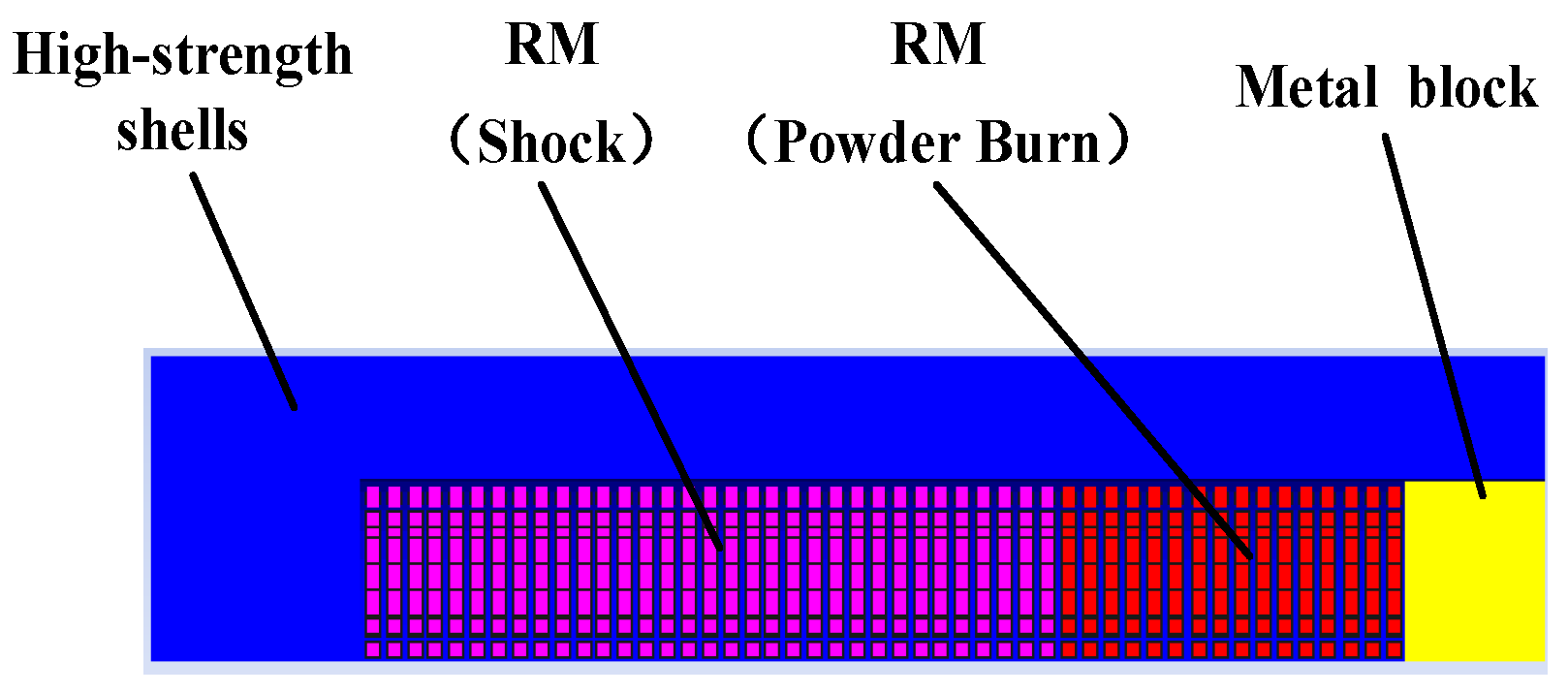
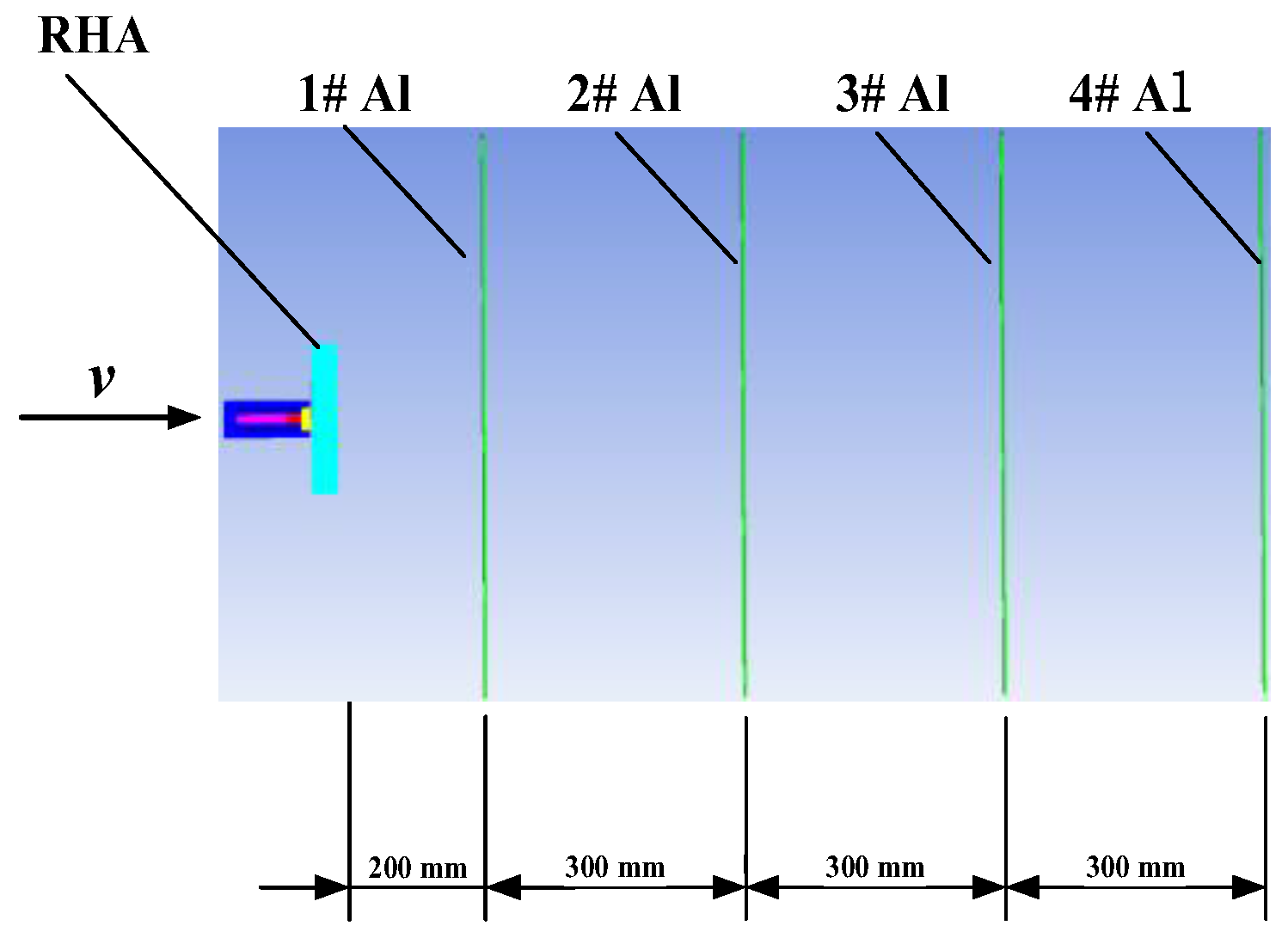
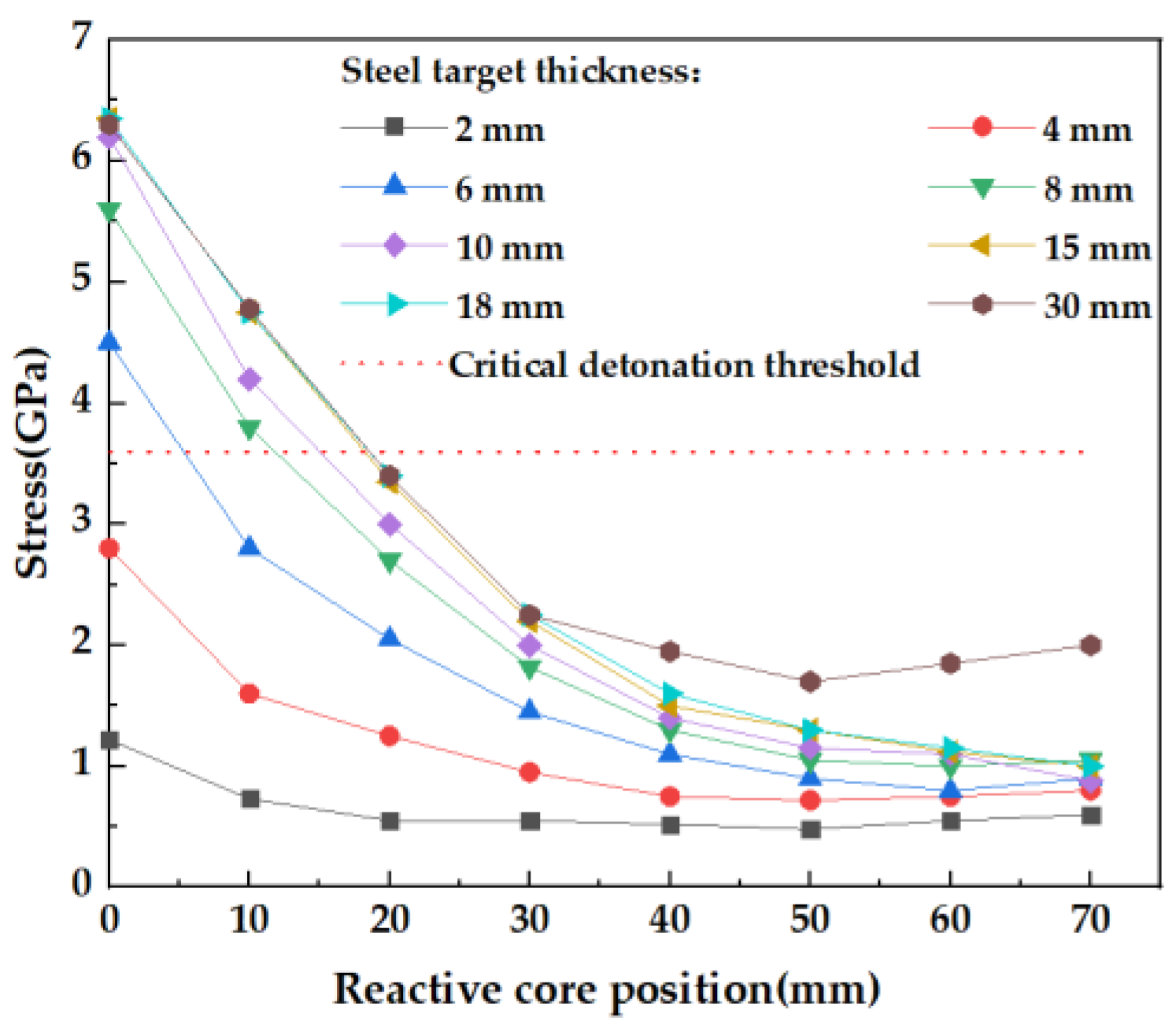

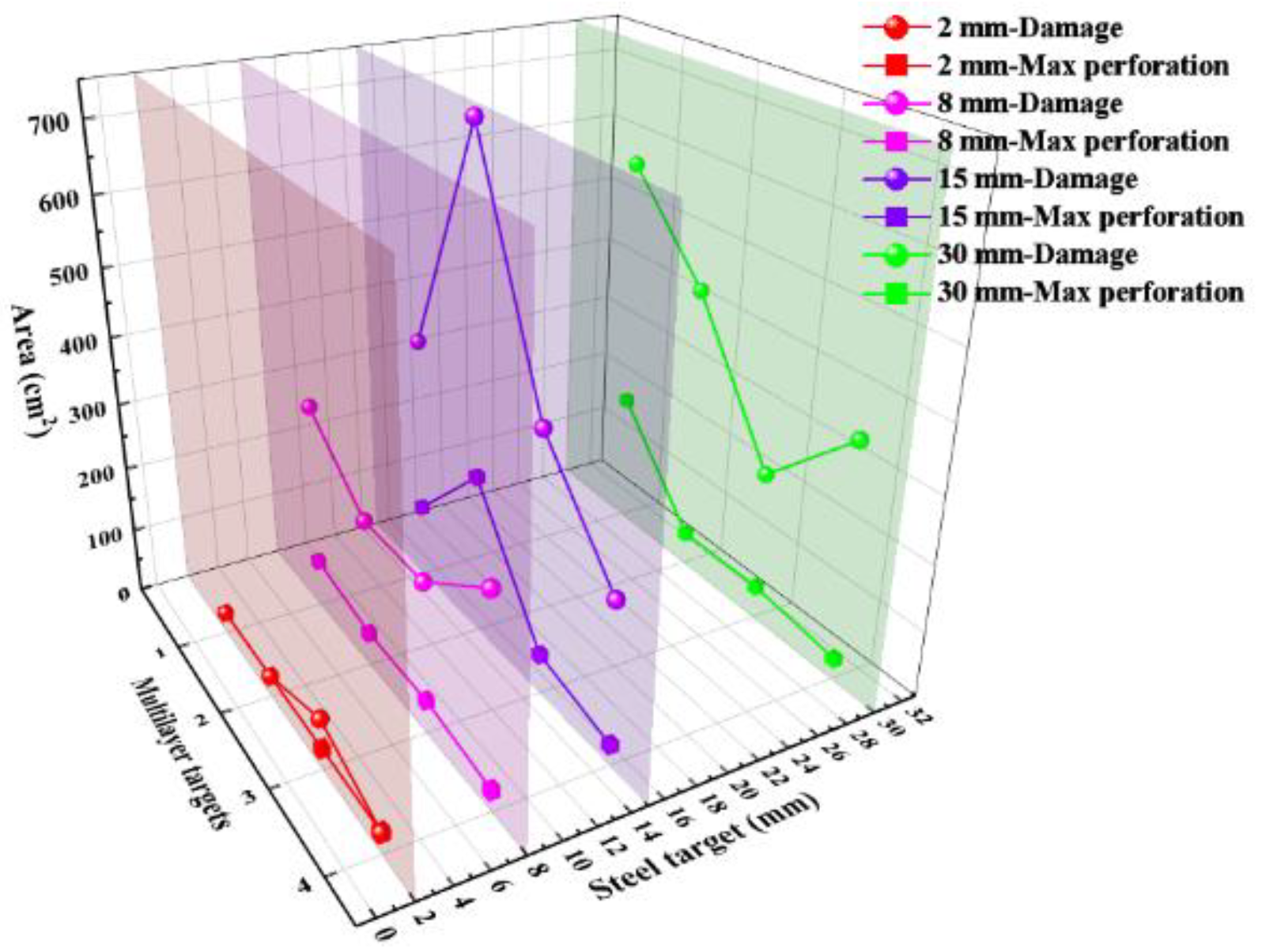
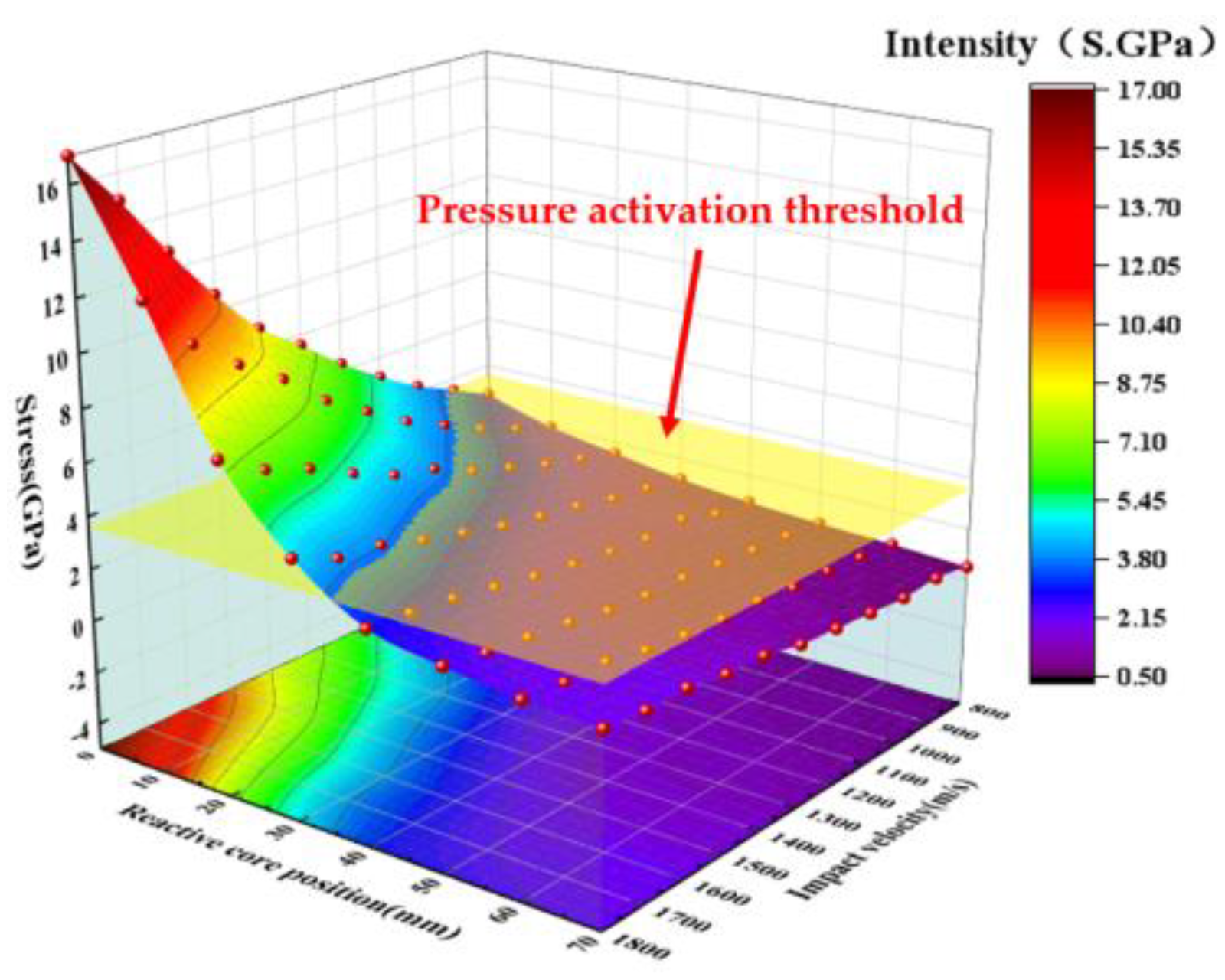

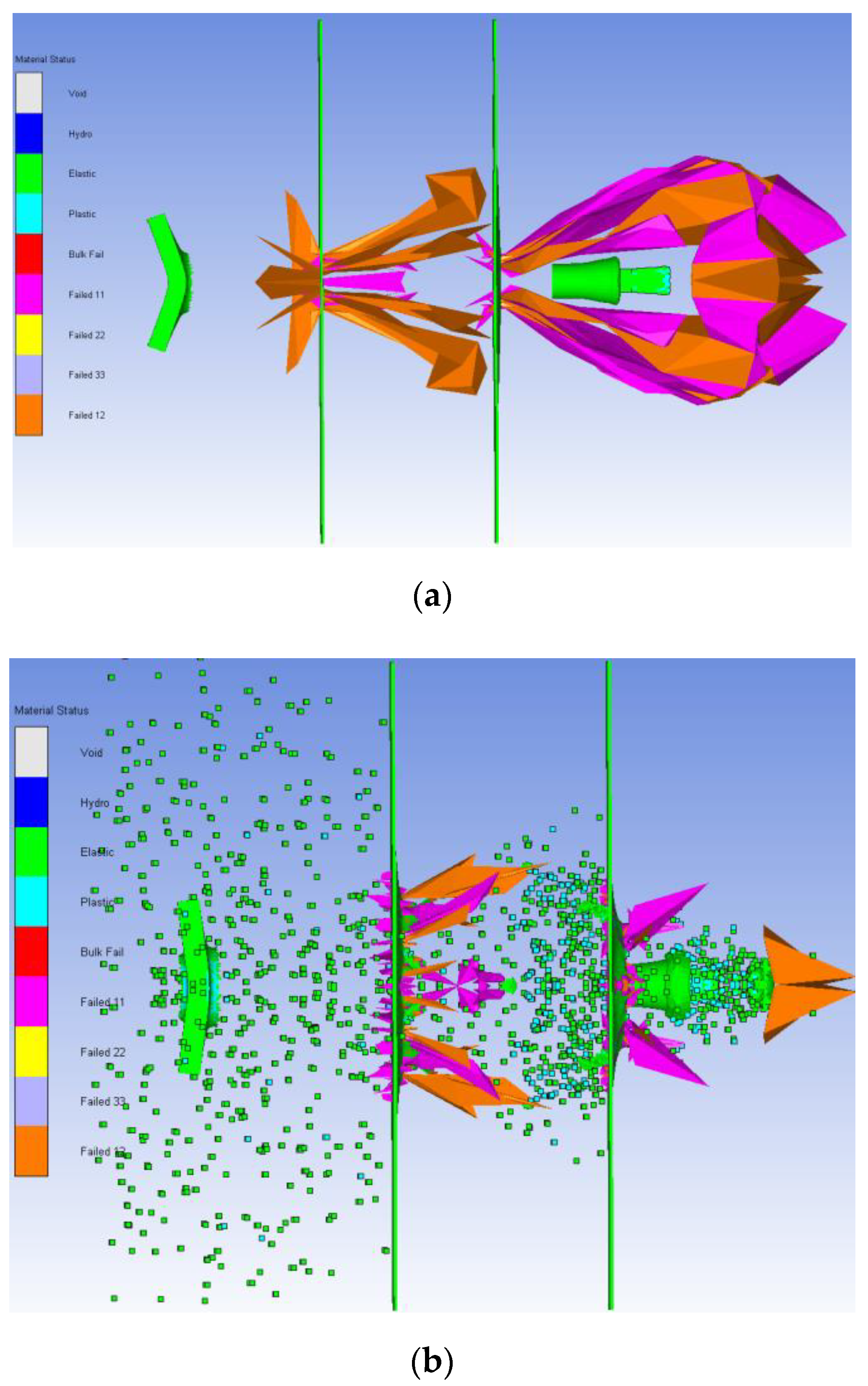
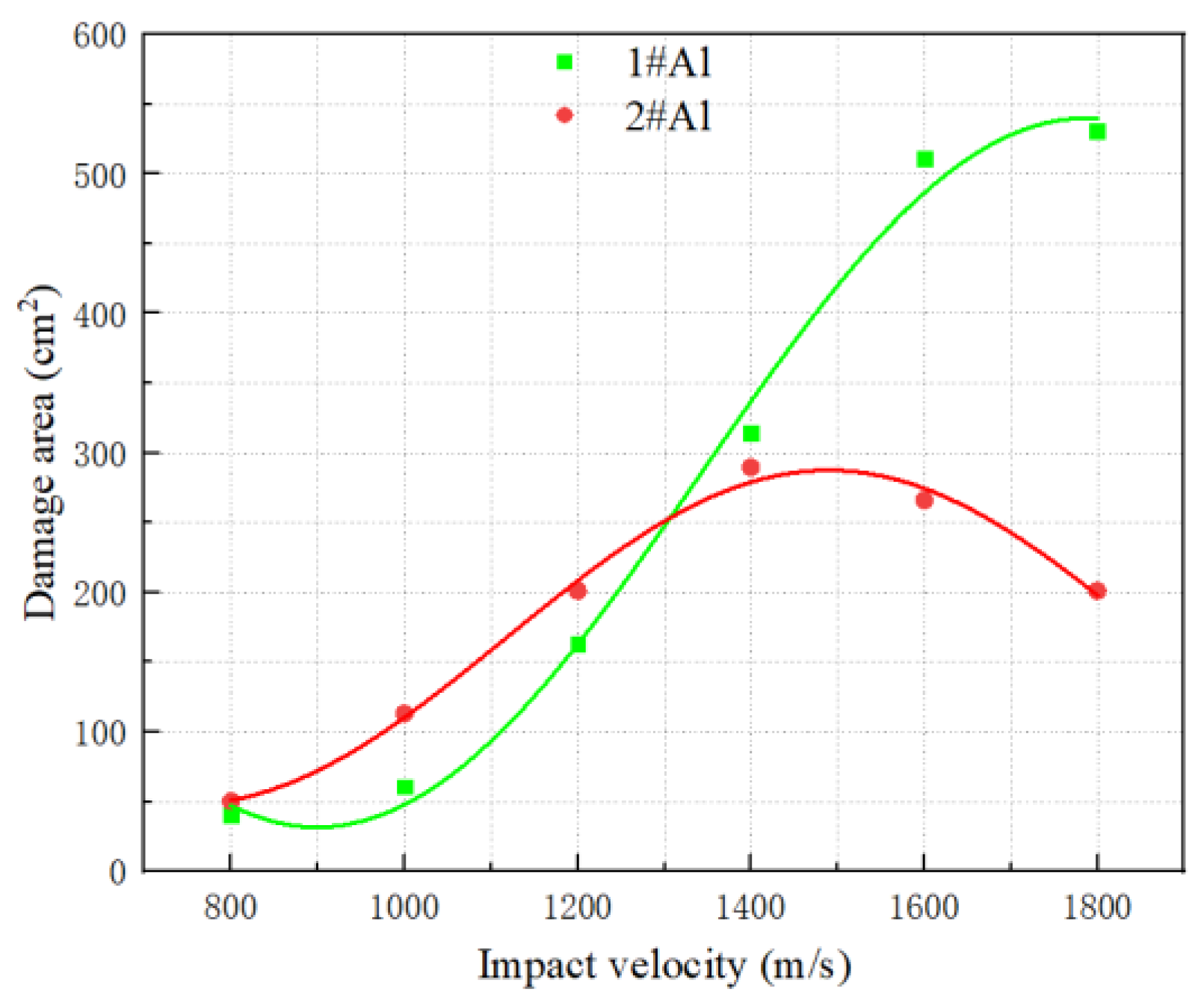
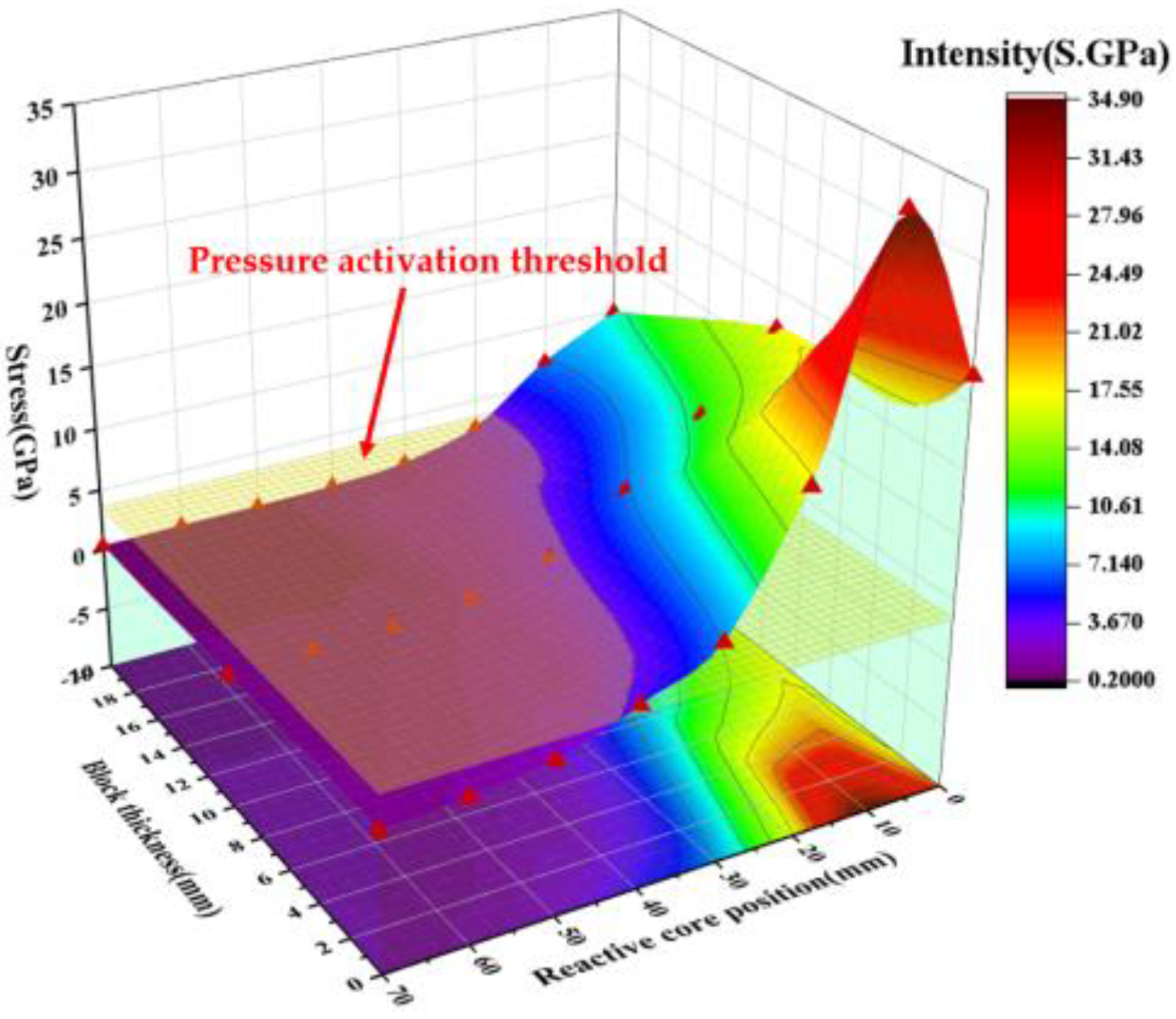
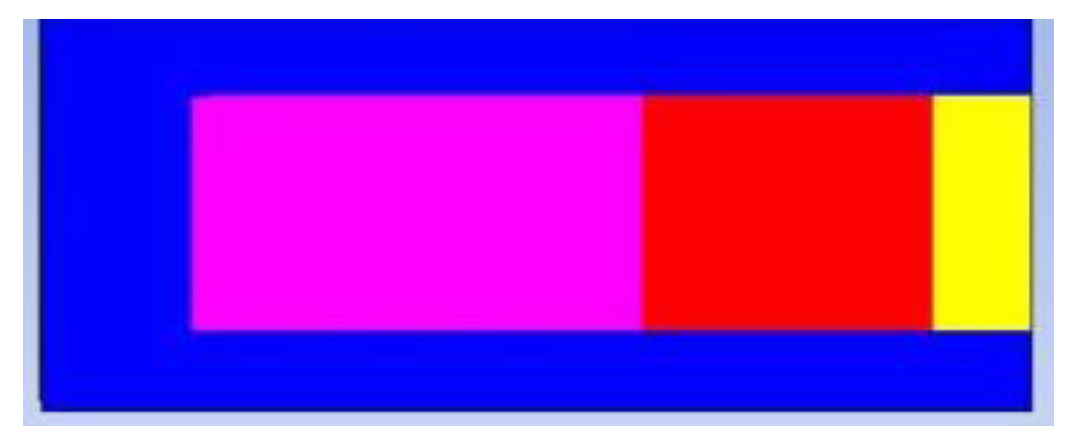

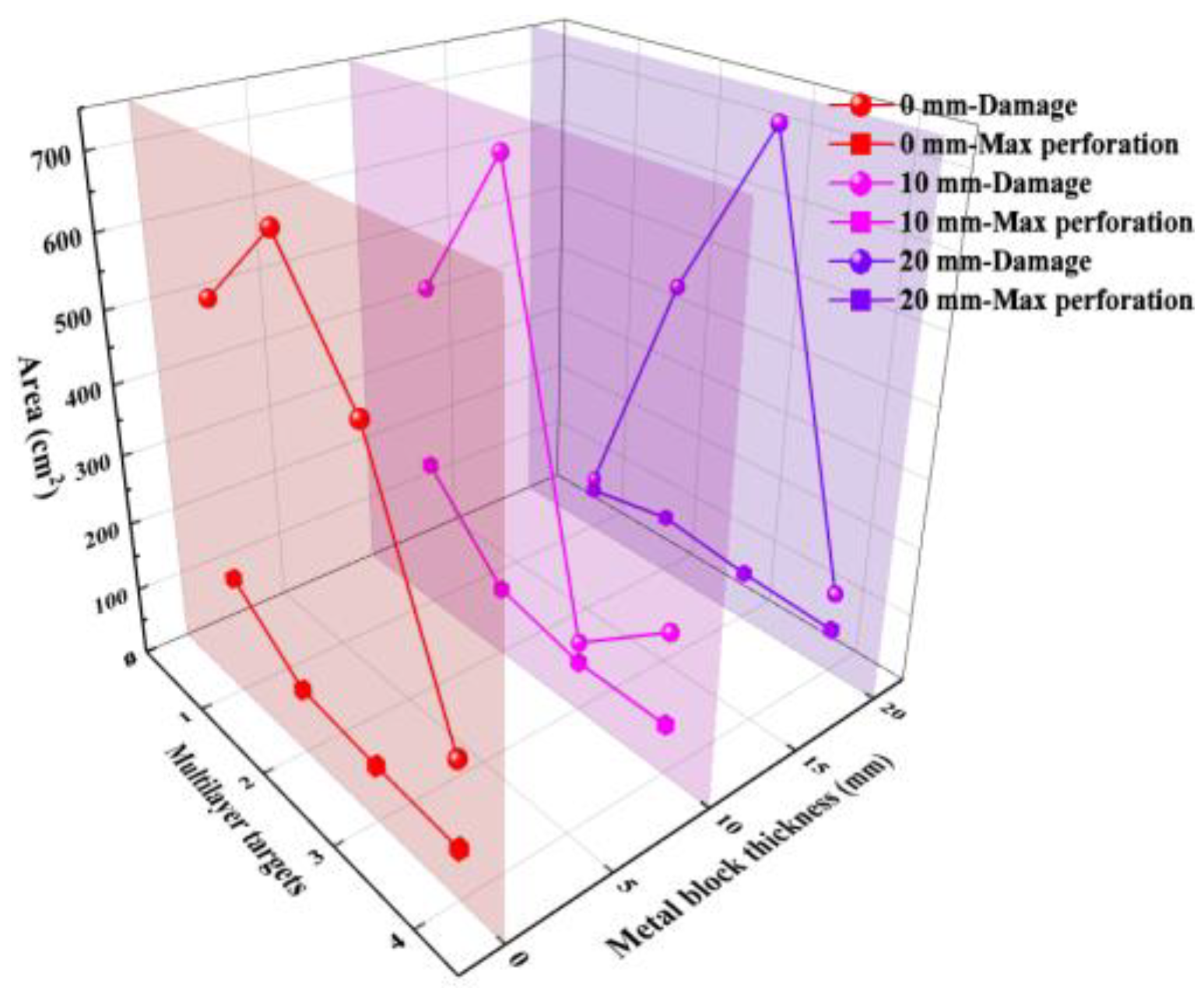
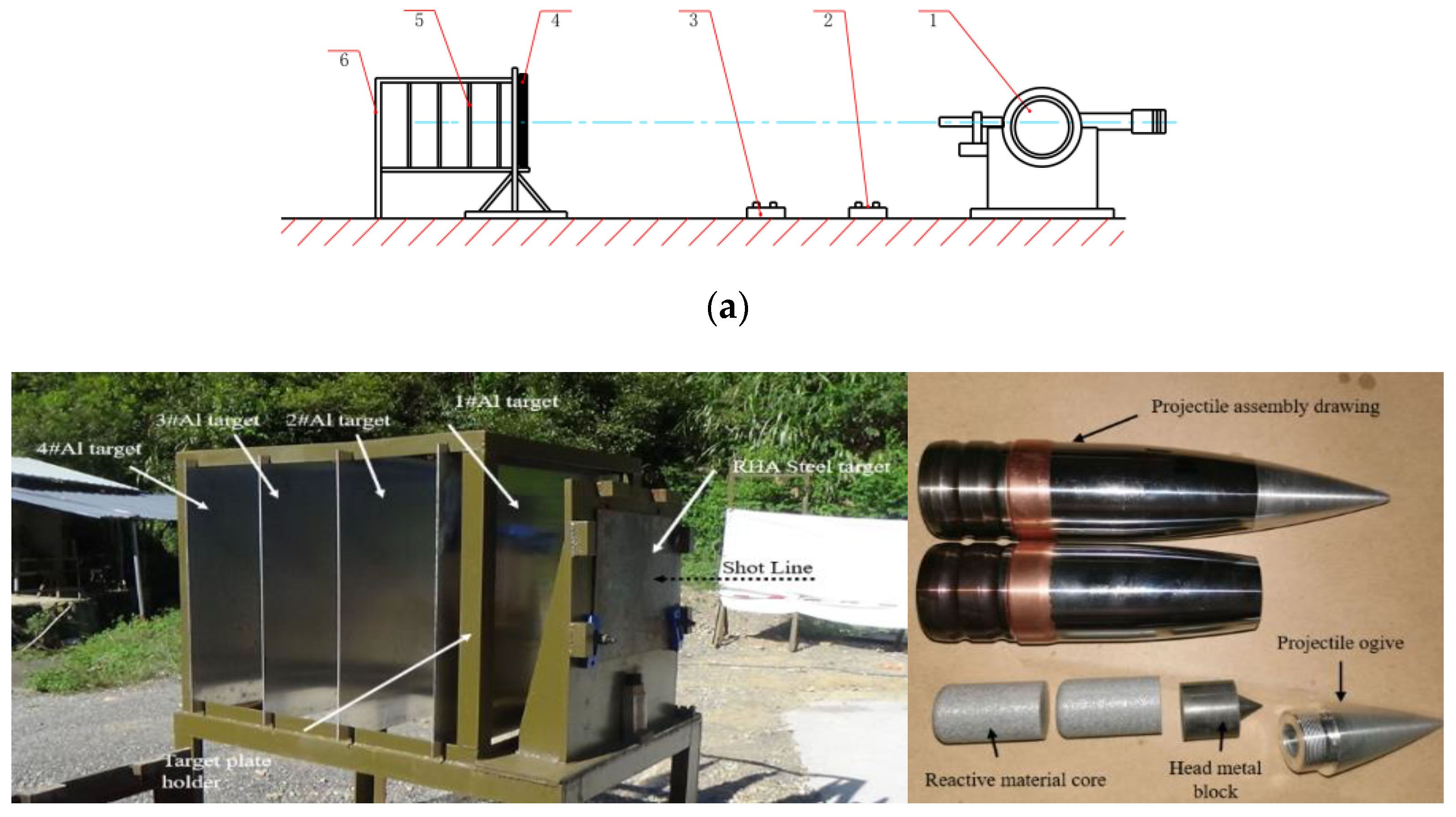
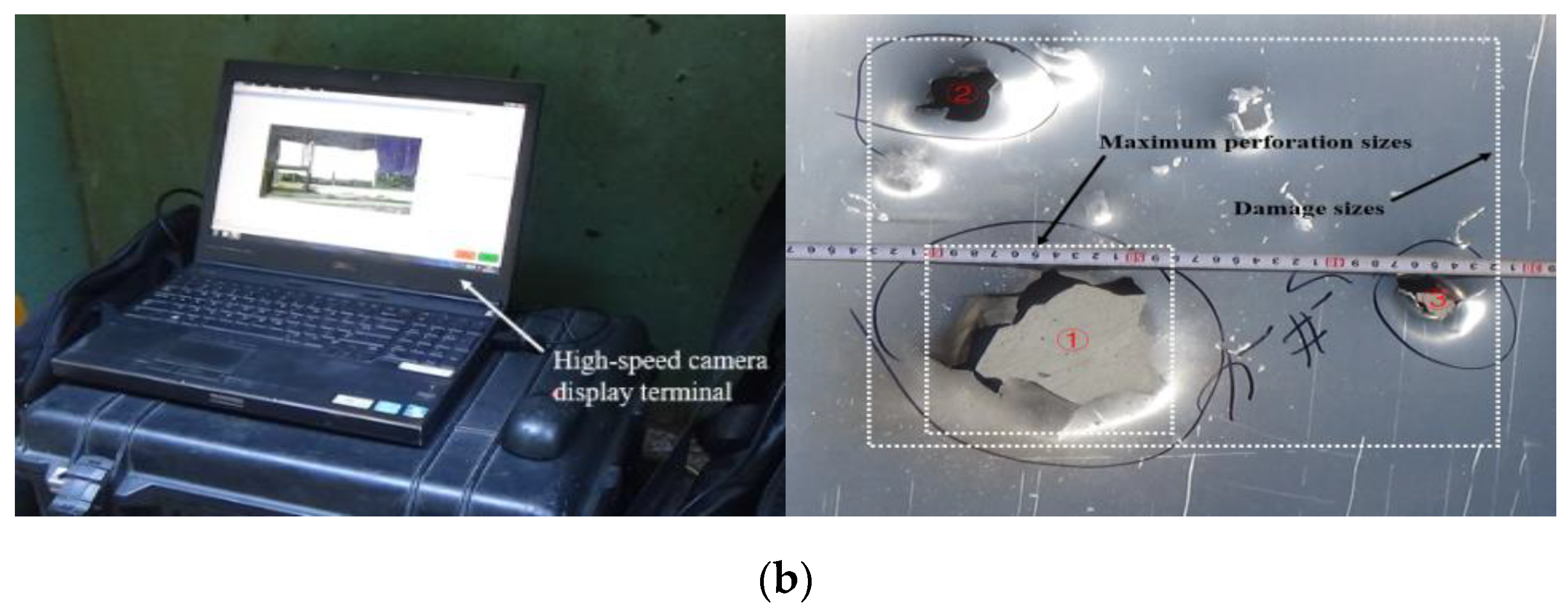
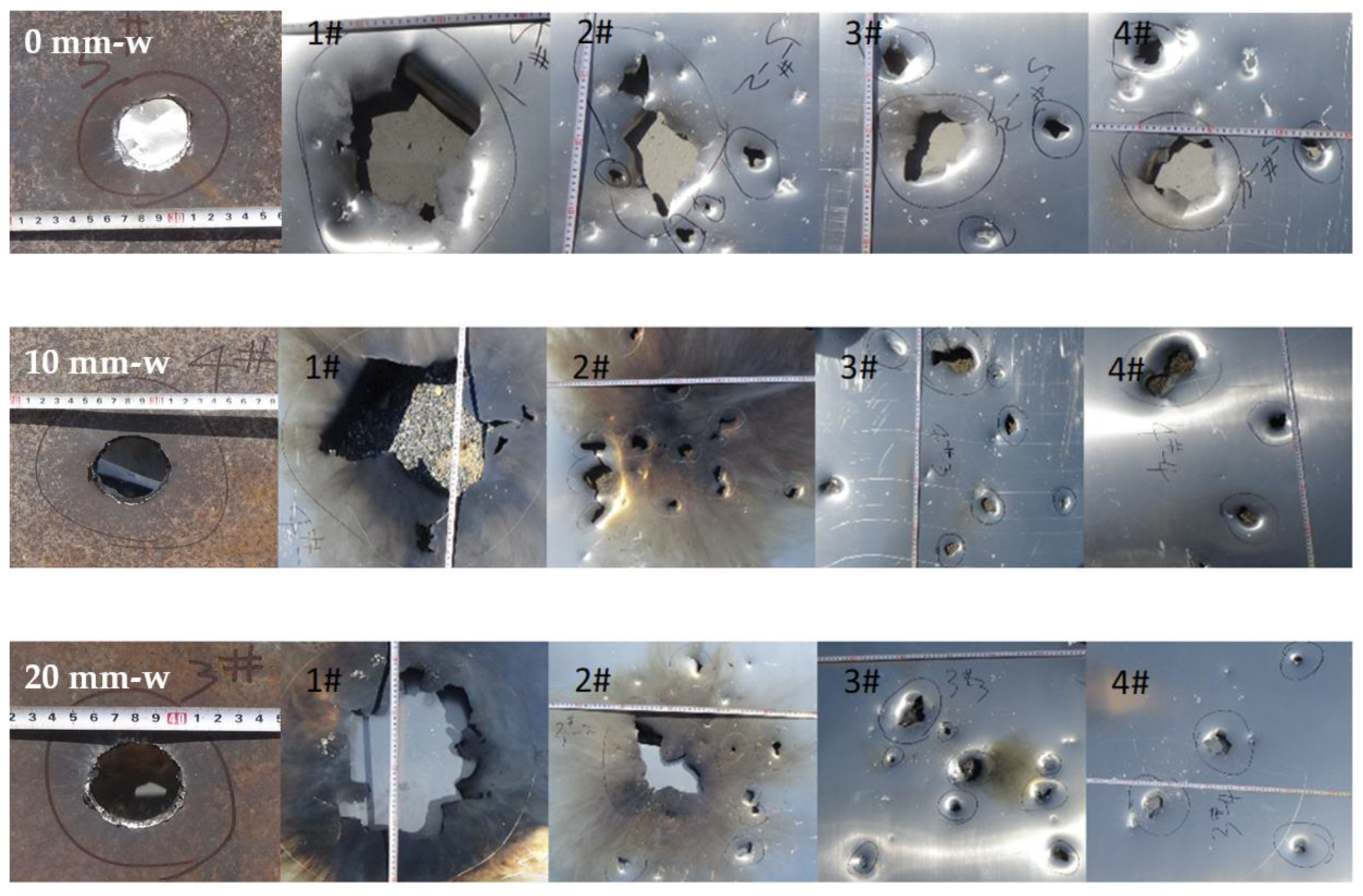


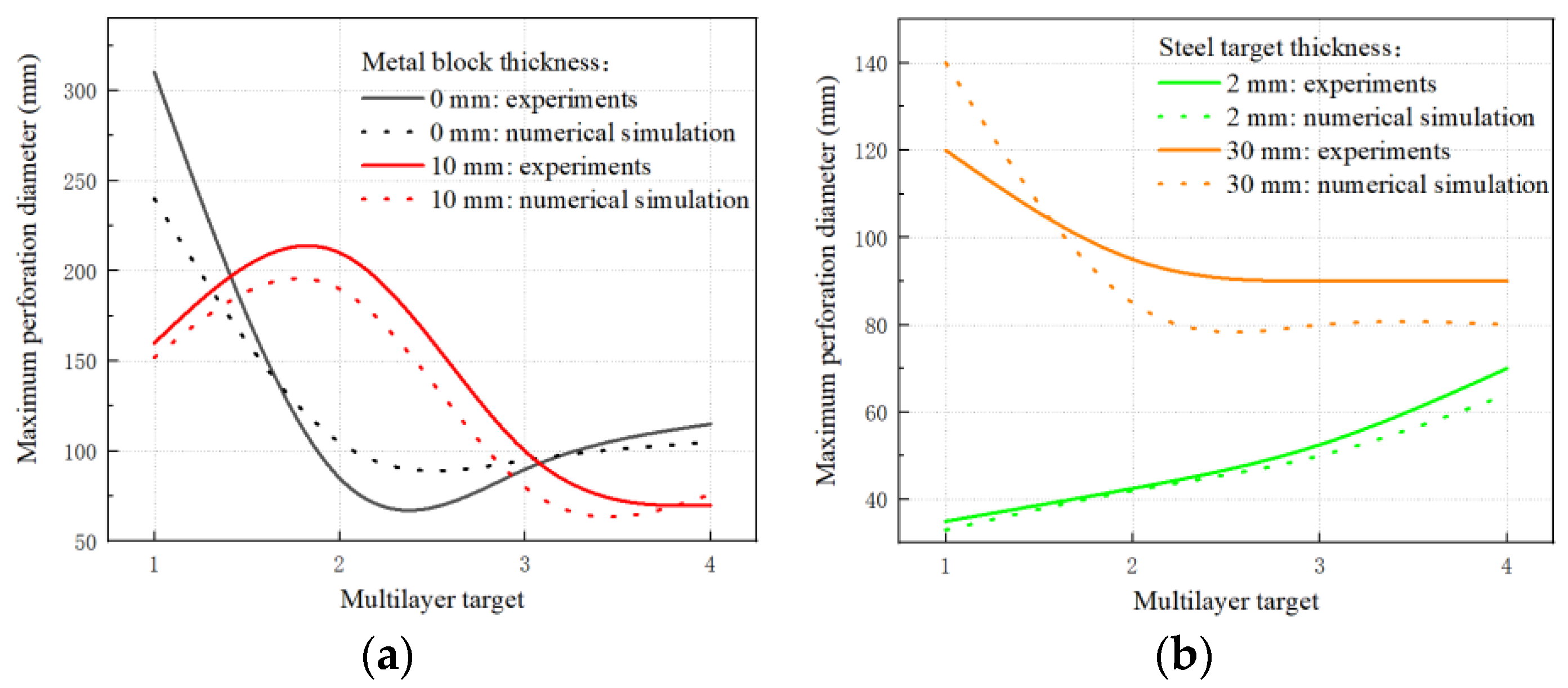
| Parts | Materials | Equation of State | Intensity Model | Invalidation Model |
|---|---|---|---|---|
| Shells | 30CrMnSiA | Shock | Johnson Cook | Principal Stress |
| Core (reactive) | PTFE/AL | Powder Burn | Johnson Cook | Principal Stress |
| Core (unreactive) | PTFE/AL | Shock | Johnson Cook | Principal Stress |
| Steel target | RHA | Shock | von Mises | Principal Stress |
| Post-effect target | AL 2024 | Shock | Johnson Cook | Principal Stress |
| Materials | Density (g/cm3) | Shear Modulus (GPa) | Yield Strength (MPa) | Specific Heat (J/kg·K) | Tensile Strength (MPa) |
|---|---|---|---|---|---|
| W.ALLOY | 17 | 160 | 1506 | 172 | 2210 |
| Core | 2.76 | 7 | 120 | / | 240 |
| AL 2024 | 2.78 | 28.6 | 260 | 1220 | 720 |
| RHA | 7.86 | 64.1 | 1500 | / | 2000 |
| 30Cr | 7.86 | 80.8 | 1800 | 460 | 1200 |
| Shot # | Thickness of RHA | Thickness of Metal Block | Impact Velocity (m/s) | Maximum Perforation Sizes (mm) Damage Sizes (mm) Perforation Number | ||||
|---|---|---|---|---|---|---|---|---|
| RHA | 1#Al | 2#Al | 3#Al | 4#Al | ||||
| 1-1 | 2 mm | 10 mm | 936 | 40 × 45 | 35 × 35 | 40 × 45 | 50 × 55 75 × 60 3 | 70 × 70 140 × 80 4 |
| 1-2 | 8 mm | 10 mm | 942 | 40 × 45 | 200 × 190 230 × 220 3 | 180 × 120 340 × 220 4 | 280 × 210 | 350 × 410 |
| 1-3 3-3 | 15 mm | 10 mm | 940 | 40 × 40 | 230 × 210 340 × 210 2 | 270 × 300 | 190 × 220 280 × 310 7 | 130 × 190 290 × 230 4 |
| 1-4 2-3 | 20 mm | 10 mm | 952 | 45 × 45 | 180 × 140 | 210 × 210 320 × 470 9 | 90 × 60 490 × 460 9 | 80 × 60 600 × 390 6 |
| 1-5 | 30 mm | 10 mm | 946 | 55 × 50 | 100 × 130 | 110 × 80 | 80 × 80 | 100 × 80 |
| 2-1 | 20 mm | 0 mm | 970 | 50 × 52 | 360 × 290 | 80 × 90 540 × 625 13 | 115 × 65 600 × 440 9 | 150 × 80 580 × 280 4 |
| 2-2 | 20 mm | 20 mm | 932 | 45 × 45 | 180 × 140 220 × 180 2 | 210 × 214 400 × 260 6 | 170 × 160 560 × 350 9 | 190 × 200 700 × 190 5 |
| 3-1 | 15 mm | 10 mm | 862 | 40 × 40 | 240 × 200 | 330 × 300 | 240 × 160 | 210 × 120 260 × 150 2 |
| 3-2 | 15 mm | 10 mm | 907 | 40 × 42 | 240 × 220 270 × 220 2 | 280 × 200 | 240 × 200 260 × 320 5 | 120 × 80 280 × 150 2 |
Publisher’s Note: MDPI stays neutral with regard to jurisdictional claims in published maps and institutional affiliations. |
© 2022 by the authors. Licensee MDPI, Basel, Switzerland. This article is an open access article distributed under the terms and conditions of the Creative Commons Attribution (CC BY) license (https://creativecommons.org/licenses/by/4.0/).
Share and Cite
Li, X.; Hou, C.; Tong, H.; Yang, L.; Chen, Y. Influential Factors of a Reactive Materials Projectile’s Damage Evolution Behavior. Crystals 2022, 12, 1683. https://doi.org/10.3390/cryst12111683
Li X, Hou C, Tong H, Yang L, Chen Y. Influential Factors of a Reactive Materials Projectile’s Damage Evolution Behavior. Crystals. 2022; 12(11):1683. https://doi.org/10.3390/cryst12111683
Chicago/Turabian StyleLi, Xiangrong, Cong Hou, Huan Tong, Lei Yang, and Yongkang Chen. 2022. "Influential Factors of a Reactive Materials Projectile’s Damage Evolution Behavior" Crystals 12, no. 11: 1683. https://doi.org/10.3390/cryst12111683
APA StyleLi, X., Hou, C., Tong, H., Yang, L., & Chen, Y. (2022). Influential Factors of a Reactive Materials Projectile’s Damage Evolution Behavior. Crystals, 12(11), 1683. https://doi.org/10.3390/cryst12111683








